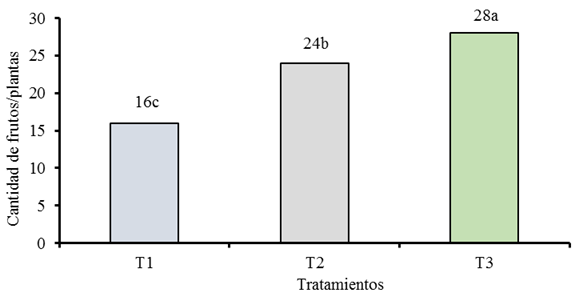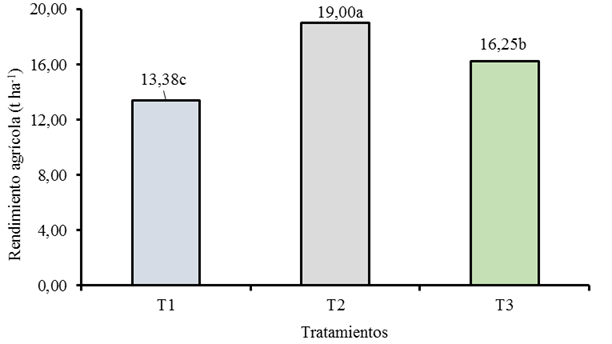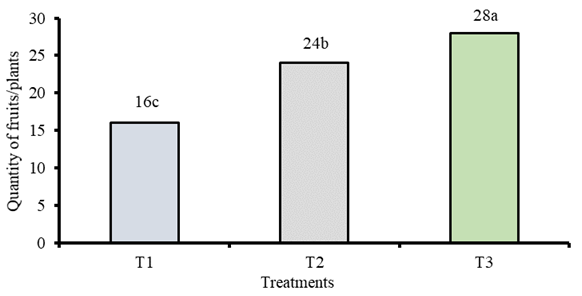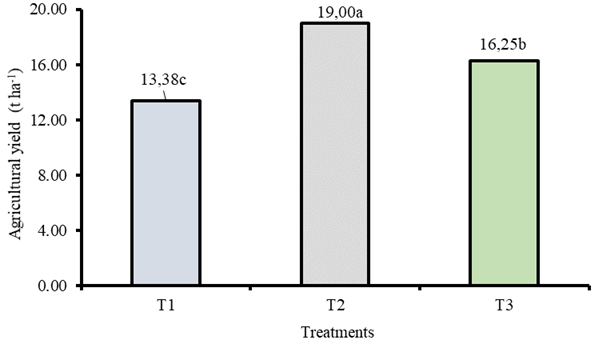INTRODUCCIÓN
El pimiento (Capsicum annuum L.) es una de las hortalizas más consumidas a nivel mundial, debido a la combinación de su sabor, el valor nutricional y económico 1,2. Se cultiva en la mayoría de los países del mundo donde las condiciones ambientales son favorables para su desarrollo 3. En Cuba, constituye una de las principales hortalizas, dado a su amplio consumo por parte de la población, así por su nivel de exportación 4,5.
En la actualidad la producción del pimiento bajo condiciones protegidas se ve limitada, debido al empleo de un marco de siembra de 15 cm entre plantas, lo que trae consigo un buen crecimiento del cultivo, pero con frutos muy pequeños. Por tal razón, los esfuerzos se encaminan a lograr un incremento sostenido de la producción de pimiento 6, para ello se destinan recursos, así como cultivares de ciclos cortos y de altos rendimientos, que permiten garantizar la demanda del producto, esto es un reto para las unidades productoras, las cuales aplican métodos y procedimientos actuales para dar respuesta a las exigencias alimentarias de la población 7.
Una de las alternativas para incrementar la producción agrícola es a través de la plantación de cultivos protegidos, esto permite extender los calendarios de producción de las hortalizas, con rendimientos elevados y estables todo el año, además de su suministro fresco al mercado nacional e internacional, con alta calidad, inclusive en los períodos en que la oferta de producción hortícola cultivada a campo abierto resulta limitada, como ocurre en el verano, una mejor opción son los sistemas protegidos, ya que en estos se pueden obtener producciones de pimiento todo el año 5,8,9.
El pimiento plantado en casas de cultivo protegido logran un incremento de los rendimientos entre 10 y 20 t ha-1 en comparación con los métodos tradicionales aplicados en la agricultura cubana a campo abierto, por lo que presenta gran ventaja 10. Sin embargo, las producciones de pimiento bajo condiciones protegidas aún no alcanzan diámetros ecuatoriales y polares, así como rendimientos agrícolas sorprendentes para satisfacer la demanda actual 2. Por lo antes planteado, este trabajo tiene como objetivo evaluar la influencia de tres marcos de siembra en el desarrollo del pimiento (Capsicum annuum L.) híbrido ‘Carleza’, bajo cultivo protegido en una Unidad Empresarial Básica de Cultivos Protegidos y Semiprotegidos de la Empresa “Paquito Rosales Benítez” del municipio Yara, Granma, Cuba.
MATERIALES Y MÉTODOS
El trabajo investigativo fue realizado en las casas de cultivo protegido “La Veguita” de la Empresa de Cultivos Varios “Paquito Rosales” del municipio de Yara de la provincia de Granma, Cuba, sobre un suelo Fluvisol11, de consistencia media, medianamente profundo, llano, sin presencia de obstáculos, con un pH de 7. Dentro de la casa de cultivo la temperatura media fue de 26 oC, con una humedad relativa de 72 % 12.
El cultivo estudiado fue el pimiento, híbrido ‘Carleza’, comercializado por la Empresa de Semillas Granma, plantado en casa de cultivo con un diseño experimental en bloques al azar, con tres tratamientos y tres réplicas, para un total de nueve canteros de 38×0,80 m de dimensión, separados a 0,60 m uno de otro. Se estableció un semillero en bandejas de germinación y el trasplante se efectuó a los 37 días de germinadas las semillas, cuando las plántulas tenían cuatros hojas verdaderas y una altura de 16 cm: a un marco de siembra de 15 cm de distancia (tratamiento tradicional, T1); marco de siembra a 40 cm de distancia (tratamiento, T2); marco de siembra a 20 cm (tratamiento, T3).
A los 15, 55 y 120 días del trasplante (DDT) fueron evaluados los parámetros morfológicos como: altura de la planta (cm), grosor del tallo (mm) a 10 cm del suelo. A los 60, 90 y 120 días del trasplante (DDT) se evaluaron los caracteres agronómicos: longitud y diámetro de los frutos ambos en cm, número de frutos por planta y el rendimiento agrícola (t ha-1). Las atenciones culturales se realizaron según el instructivo técnico 13.
Una vez tomados los datos, se realizó un análisis de varianza (ANOVA) de clasificación doble con el paquete estadístico STATISTICA 14 y cuando existieron diferencias significativas entre los tratamientos, se empleó la prueba de comparación múltiple de LSD de Fisher para una probabilidad p<0,95.
RESULTADOS Y DISCUSIÓN
Altura de las plantas de pimientos (cm)
En la Tabla 1 se muestra la altura de las plantas de pimiento en cada uno de los tratamientos durante tres fechas de observación, donde se encontró diferencias significativas entre los tratamientos, según la prueba de LSD de Fisher realizada para p<0,95, donde T1, mostró plantas con una altura media de 123,10 cm, superior en 38 y 14 % a la altura media de las plantas alcanzadas por T2 y T3, respectivamente.
Tabla 1.
Altura de las plantas (cm) de pimiento (Capsicum annuum L.) híbrido ‘Carleza’, en diferentes marcos de siembra, bajo condiciones protegidas
*Fecha de observación: 1, a los 15 días de plantado el cultivo, 2, a los 55 días de plantado el cultivo, 3, a los 120 días de plantado el cultivo.
**T1, marco de trasplante a 15 cm de distancia, T2, marco de trasplante a 40 cm de distancia, T3, marco de trasplante a 20 cm de distancia.
En cada fila las cifras seguidas por la misma letra minúscula no son significativamente diferentes para (p<0,95) según la prueba de LSD de Fisher. En una columna las cifras seguidas por la misma letra mayúscula no son significativamente diferentes para (p<0,95) según la prueba de LSD de Fisher
A los 15 días de plantado el cultivo, primera fecha de observación, las plantas de pimiento en T2 con 24,67 cm de altura, mostraron diferencias significativas, con relación a las plantas evaluadas en T1 y T3 con 27,70 y 27,65 cm altura, respectivamente. Las alturas de las plantas alcanzadas en T1 y T3 superaron a la altura de 25,75 cm determinada por otros autores 15.
A los 55 días de plantado el cultivo, segunda fecha de observación, hay un incremento del tamaño de las plantas de 67, 61 y 64 % en T1, T2 y T3, donde T1, mantiene las plantas de mayor altura, con valores de 83,26 cm en relación con T3 y T2.
Algo similar se observa a los 120 días de plantado el cultivo, tercera fecha de observación, donde se evidenció un incremento del crecimiento de las plantas de 68, 54 y 64 % en T1, T2 y T3, respectivamente, con relación a la altura de las plantas, alcanzada en la segunda fecha de observación. En esta fecha las plantas alcanzaron un buen crecimiento, con altura por encima de los 100 cm (203,89 cm), en particular T1, con plantas con una altura de 258,33 cm, 46 y 17 % superiores a las plantas obtenidas por T2 (140,00 cm) y T3 (213,33 cm). Este resultado pudo deberse a que las plantas al estar más unidas en T1 que en T2 y que en T3 compiten entre ellas en la búsqueda de agua y de luz solar, esto favorece su crecimiento.
No obstante, la altura alcanzada por las plantas en T1, T2 y T3 está por encima de la altura alcanzada por los cultivares de pimientos del tipo F6xLB F1 y Nathalie estudiados por varios autores 2,6, donde se observaron plantas con una altura de 124,7 y 136,3 cm, respectivamente en sistemas de cultivo protegido. Esta altura es considerada de buena, ya que para la explotación del pimiento, bajo sistemas de cultivo protegido, requiere de plantas de tallos muy largos y rectos que sobrepasen los 2 m de altura, para facilitar las labores de manejo y asegurar más producción por área 6.
Grosor del tallo del cultivo de pimiento (mm)
Para el grosor de los tallos, en la primera fecha, los tratamientos no presentaron diferencias significativas para p<0,95, según la prueba de LSD de Fisher (Tabla 2), con tallos entre 4,73 y 5,07 mm de grosor. En la segunda fecha se mostró un pequeño incremento pero sin diferencia entre los tratamientos. Sin embargo, en la tercera fecha, el grosor de los tallos obtenidos por T2 (15,33 mm), fueron significativamente mayores que los obtenidos por T1 (13,67 mm) y T3 (14,00 mm). Al igual que en la altura de las plantas, la tercera fecha resultó ser la mejor en relación con la primera y que la segunda fecha de observación, con plantas de 14,33 mm de grosor, destacándose T2 con el mejor resultado, donde su valor supera a lo alcanzado por cultivares de pimientos del tipo 2x4 F1 y Nathalie, estudiados por varios autores 2,6, con tallos de 12,7 y 14 mm de grosor, respectivamente, en sistemas de cultivo protegido.
Tabla 2.
Grosor del tallo de las plantas (mm) de pimiento (Capsicum annuum L.) híbrido ‘Carleza’ en diferentes marcos de siembra bajo condiciones protegidas
*Fecha de observación: 1, a los 15 días de trasplante del cultivo, 2, a los 55 días de trasplante del cultivo, 3, a los 120 días de trasplante del cultivo.
**T1, marco de trasplante a 15 cm de distancia, T2, marco de trasplante a 40 cm de distancia, T3, marco de trasplante a 20 cm de distancia.
En cada fila las cifras seguidas por la misma letra minúscula no son significativamente diferentes para (p<0,95) según la prueba de LSD de Fisher. En una columna las cifras seguidas por la misma letra mayúscula no son significativamente diferentes para (p<0,95) según la prueba de LSD de Fisher
Longitud y diámetro de los frutos de pimiento (cm)
Con relación a la dimensión de los frutos de pimientos, los tratamientos presentaron diferencias significativas entre ellos (Tabla 3), donde T2 alcanzó frutos con longitud media de 7,98 cm, 16 y 7 % superior a la longitud media alcanzada por T1 y T3, con valores medio de 6,70 y 7,39 cm, respectivamente. La longitud de los frutos obtenido por T2, estuvo en correspondencia con el diámetro medio de los frutos, donde T2, alcanzó frutos con un diámetro medio de 8,75 cm, mayor que el diámetro medio alcanzado por T1 y T3, con valores de 7,98 y 7,76 cm, respectivamente. La longitud y diámetro de los frutos obtenidos por T2, están por debajo de los valores alcanzados por los cultivares del tipo FAR-3 F1 y F6xLB F1 estudiados por varios autores 6,16 con frutos de 12,0 y 14,95 cm de longitud por 9,10 y 9,12 cm de diámetro, respectivamente en sistema de cultivo protegido.
Al analizar las fechas de observación, para la longitud y diámetro de los frutos se observa una reducción del 24 y 20 % del tamaño de los frutos, respectivamente al llegar a la tercera fecha (Tabla 3), en relación con la primera fecha de observación. Este resultado indica que en T1, T2 y T3 la longitud de los frutos varió en 2,32; 1,03 y 2,4 cm, respectivamente y el diámetro de los frutos varió en 2,16; 1,47 y 1,56 cm respectivamente, ambos con relación a la primera fecha de observación. En este caso la longitud y el diámetro de los frutos obtenidos por T2 y T3, fueron más estables que en T1, ya que no se encontró diferencias significativas entre la primera y la segunda fecha. El tamaño de los frutos se corresponden con el rango de 8 cm de longitud por 9 cm de diámetro, establecido por el instructivo técnico 13, para este tipo de híbrido de pimiento; así mismo, se ajusta a los valores obtenidos por el cultivar del tipo California Wonder, estudiado por varios autores 5, con frutos entre 4,85 a 6,01 cm de diámetro y de 8,18 a 9,30 cm de longitud, respectivamente. El T2 y T3 garantizan frutos de un buen tamaño, ya que para el consumo fresco se requieren frutos de buen tamaño, aunque otros autores señalan que los cultivos se diferencian, no sólo por el color o tamaño, sino por su actitud para lograr una buena producción 6,17.
Tabla 3.
Longitud y diámetro de los frutos (cm) de pimiento (Capsicum annuum L.) híbrido ‘Carleza’ en diferentes marcos de siembra bajo condiciones protegidas
*Fecha de observación: 1, a los 15 días de trasplante del cultivo, 2, a los 55 días de trasplante del cultivo, 3, a los 120 días de trasplante del cultivo.
**T1, marco de trasplante a 15 cm de distancia, T2, marco de trasplante a 40 cm de distancia, T3, marco de trasplante a 20 cm de distancia.
En cada fila las cifras seguidas por la misma letra minúscula no son significativamente diferentes para (p<0,95) según la prueba de LSD de Fisher. En una columna las cifras seguidas por la misma letra mayúscula no son significativamente diferentes para (p<0,95) según la prueba de LSD de Fisher
Cantidad de frutos por plantas
La cantidad de frutos por plantas (Figura 1) evidencian que existen diferencias significativas entre los tratamientos, según la prueba de LSD de Fisher para p<0,95, donde se observa que T3 alcanzó la mayor cantidad de frutos (28 frutos/plantas), superior en un 43 y 14 % a la cantidad de frutos obtenidos por T1 y T2 con 16 y 24 frutos/plantas, respectivamente. La cantidad de frutos/plantas alcanzados por T3 supera en 11 % (tres frutos) a la cantidad de frutos reportados por los cultivares de pimientos del tipo F9xBM29 F1 y F9x330 F1 estudiados por varios autores 6,18 con 25 frutos/plantas, respectivamente.
Es de destacar que las plantas en T3 presentaron una mejor floración y fructificación, lo que permitió alcanzar mayor cantidad de frutos por plantas que en T1 y que T2. Debido a la temperatura que se produce dentro de la casa de cultivo en horas del mediodía muchas de las flores son abordadas por las plantas, produciendo efectos negativos para el rendimiento del cultivo. No obstante los resultados alcanzados en T1, T2 y T3 superan a los reportados por otros autores con 6,7 frutos por plantas en invernaderos2.

Cifras con letras iguales no difieren significativamente para (p<0,95)
Figura 1.
Cantidad de frutos por plantas de pimientos (Capsicum annuum L.) híbrido ‘Carleza’ en diferentes marcos de siembra bajo condiciones protegidas
Rendimiento agrícola del cultivo de pimiento (t ha-1)
Al evaluar el rendimiento agrícola alcanzado, se observa que hay diferencias significativas entre los tratamientos, según la prueba de LSD de Fisher para p<0,95 (Figura 2). Donde T2, mostró el mayor valor 19,00 t ha-1, superior en 30 y 14,5 % al rendimiento alcanzado por T1 (13,38 t ha-1) y T3 (16,25 t ha-1), respectivamente. Este resultado de T2 se corresponde con el rendimiento de 19,7 t ha-1, alcanzado por el cultivar de pimiento del tipo California Wonder, estudiado por varios autores 5. Sin embargo, se encuentra por debajo del rendimiento agrícola de 115 y 105 t ha-1 alcanzados por los cultivares de pimiento del tipo Vargas y Tejas estudiado por otros autores 19, bajo condiciones de cultivo protegido y de igual forma al rendimiento de 120 a 140 t ha-1 año-1, reportados por el cultivar de pimiento del tipo LPD-5´F estudiado por diversos autores de procedencia cubana 18. No obstante, supera a los valores de rendimientos obtenidos por otros autores, a campo abierto, entre 11 y 13 t ha -1 (9) . La variación del marco de siembra tradicional, por uno de 40 cm (T2) entre plantas, favoreció una mejor dimensión de los frutos, para obtener un rendimiento por encima de los demás marcos de siembra T1 y T3.

Cifras con letras iguales no difieren significativamente para (p<0,95)
Figura 2.
Rendimiento del cultivo de pimiento (Capsicum annuum L.) híbrido ‘Carleza’ en diferentes marcos de siembra bajo condiciones protegidas
CONCLUSIONES
El mayor rendimiento agrícola del cultivo, la mejor dimensión de los frutos y el grosor del tallo de las plantas de pimiento se alcanzó con la aplicación del marco de siembra a 40 cm de distancia entre plantas.
El marco de siembra a 40 cm de distancia entre plantas es factible para el pimiento bajo casa de cultivo protegido.

